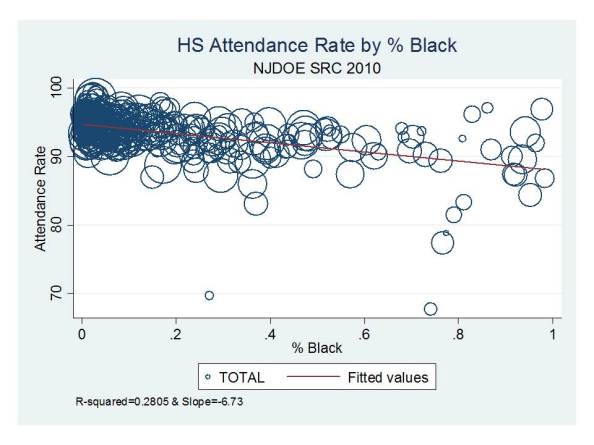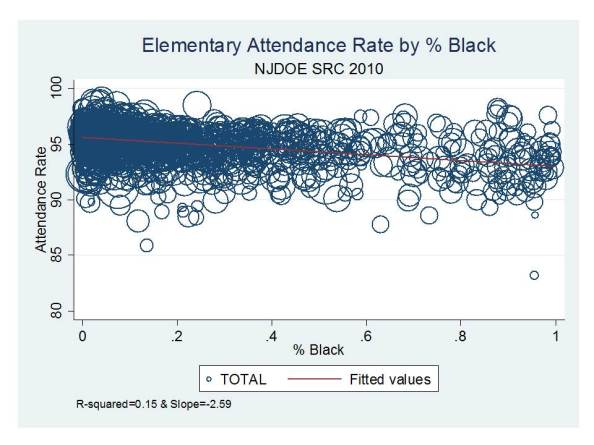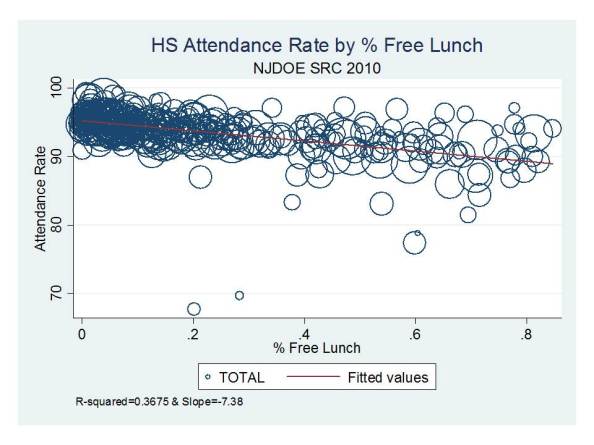Student Enrollments & State School Finance Policies
Most readers of the NJDOE report on reforming the state’s school finance formula likely glided right past the seemingly innocuous recommendation to shift the enrollment count method for funding from a fall enrollment count to an average daily attendance figure. After all, on its face, the argument provided seems to make sense. Let’s fund on this basis so that we can incentivize increased attendance in our most impoverished and low performing districts. (Another argument I’ve heard in other states is “why would we fund kids who aren’t there?”). The data were even presented to validate that attendance rates are lower in these districts (Figure 3.1).
I, however, could not let this pass, because Average Daily Attendance as a basis for funding is actually a well understood trick of the trade for reducing aid to districts and schools with higher poverty and minority concentrations. I have both blogged about this topic in the past, and written published research directly and indirectly related to the topic.[1]
The intent of this blog post is to provide a (very limited, oversimplified) primer on the common methods of counting general student populations for purposes of determining state aid to schools (charter and district) and to provide some commentary on the pros and cons of each.
This blog post doesn’t touch upon the layers of additional factors associated with counting all of the various special student categories that may drive additional aid to local public school districts and charter schools. I have, however, written numerous articles and reports on that topic as well. I’m writing about the underlying, basic count methods in this post because they are so often overlooked. But, they tend to have multiplicative effects throughout state school finance formulas.
So, here’s the primer (in somewhat oversimplified terms since there are multiple permutations on each):
Definitions
Fall Enrollment Count
A fall enrollment or fall attendance count is often based on the count of students either enrolled or specifically in attendance on a single date early in the fall of the school year (Oct 1, Oct 15, etc.). That figure may be based on students who have enrolled in a district or on students who actually attended on the given day. These single day counts in the fall are sometimes reconciled with a spring/January re-calculation leading to either upward or downward adjustments in remaining aid payments.
Average Daily Attendance
Average daily attendance counts are based on the numbers of children actually in attendance in a school or district each day, then, typically averaged on a bimonthly or quarterly basis in order to determine mid-year adjustments to state aid.
Average Daily Membership
Average Daily Membership or Average Daily Enrollment measures the numbers of children enrolled to attend a specific district throughout the year, and may also be periodically reconciled, as students enter and leave the district or school mid-year.
Comments on Each
Fall Enrollment Count
Fall enrollment counts allow for rational annual budget planning. Note that there is a difference between enrollment and attendance. Conceptually, attendance can’t exceed enrollment, if enrollment represents all those eligible to attend and enrolled to attend a particular school or district. To some degree, it makes sense to base funding on the students enrolled rather than those that can be tracked down to attend on a single day in the fall.
Single point in time enrollment counts do not allow for mid-term adjustments to aid when students come or go during the school year. One might argue that this means that districts with significant mid-year attrition will be overpaid throughout the year. But these districts have had to plan their budgets and staffing based on the numbers they expected at the beginning of the year (though usually state aid estimates for budgeting purposes are based on prior year fall enrollments), and cannot easily make mid-year adjustments to accommodate losses in aid resulting from losses in students.
Average Daily Attendance (ADA)
One major problem with ADA is that districts must plan their budgets and staffing on an annual basis, and mid-year adjustments based on attendance counts, result in reductions in aid that are difficult to absorb mid-stream in the school year. The bottom line is that districts and charter schools are obligated to have services available for all who might attend, not just all who do on a given day.
In addition, districts with higher poverty concentrations and high minority concentrations tend to have lower attendance rates for a variety of reasons beyond their control. Students from disrupted, low income households are more likely, for example to have illnesses that go untreated, be malnourished or be exposed to other factors (second hand smoke & other environmental hazards) that compromise their health. They have less access to transportation, and often come from single parent households, limiting parental supports to get them out the door to school. One cannot fix these factors by reducing aid to school districts facing these dilemmas.
It is well understood that financing schools on the basis of average daily attendance systematically reduces aid to higher poverty districts. The NJDOE report acknowledges that funding on this basis would lead to a reduction in aid of over 3% for districts in DFG A versus average districts (see figure 3.1). Further, there is no substantive evidence that funding formulas based on ADA have ever improved or better balanced student attendance rates by district poverty and race over time.
Using ADA as the basis for determining funding can have other unintended consequences, such as increased numbers of school closure days in order to reduce the risk of low attendance.[2] School districts might, for example, choose to close for increased numbers of days during flu season, as attendance drops off. Closures typically do not reduce average daily attendance. In fact, closures are used by schools/districts operating under this model as a way to avoid low attendance days. And some districts may be more significantly affected than others in this regard. Weather related decisions may also be affected.
Average Daily Membership (ADM)
ADM requires the State in collaboration with school districts to accurately manage their enrollment information. It is unclear if NJDOE has the present ability to implement ADM in New Jersey
As with average daily attendance, districts plan their budgets and staffing on an annual basis, and mid-year adjustments to enrollment, leading to reductions in aid, may not easily be absorbed mid-stream.
Within year moves tend to more often affect higher poverty, urban districts,[3] potentially causing greater fluctuations in the budgets of these districts and complicating their financial planning.
A Few Examples from States
States in the Northeast do not tend to use Average Daily Attendance as their method for determining school aid. Rather, New York State had been using attendance as a factor in a prior school funding formula.[4] Presently among Northeastern states, Connecticut uses Resident Pupils within its Education Cost Sharing Formula,[5] New York uses ADM toward the estimation of Total Aidable Foundation Pupil Units*,[6] Pennsylvania uses ADM,[7] Massachusetts uses a Fall Enrollment figure,[8] and Rhode Island uses ADM.[9] Other states around the country, including Kansas[10] and Colorado[11] use a fall enrollment count date. Many others around the country use variations on either ADM or FTE, including Florda and Tennessee. A few states — e.g., Missouri,[12] Texas and Illinois — still use ADA. But published literature and legal analyses have, in fact, criticized the racially disparate effects of Missouri’s school funding formula (prior to recent reforms).[13]
Application to New Jersey Data
So, just how disparate are attendance rates across New Jersey school districts, by race and low income status, as well as by district factor grouping? Here are a few quick graphs based on the 2010-11 school level data on enrollments (enr file from NJDOE) and attendance rates (school report card d-base).
In short, what these graphs show is that if aid were allocated by average daily attendance as opposed to by enrollment or membership, districts with higher percent black population or higher percent low income, would receive systematic reductions to their state aid. These reductions would be non-trivial. High school attendance in a school that is 100% black is, on average, nearly 7% lower than in a school that is 0% black. In elementary schools, the differential is between 2% and 3%. These differentials would translate directly to percent reductions in aid.
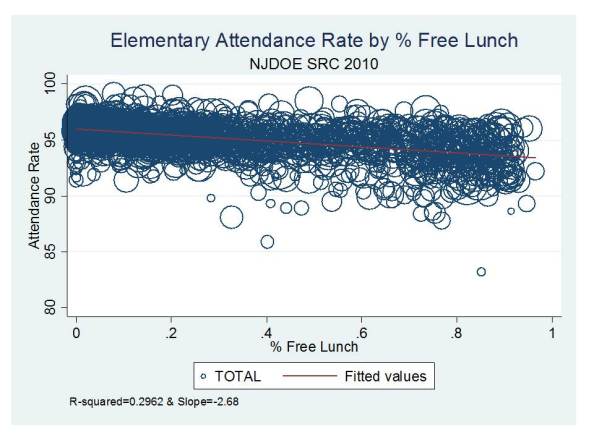
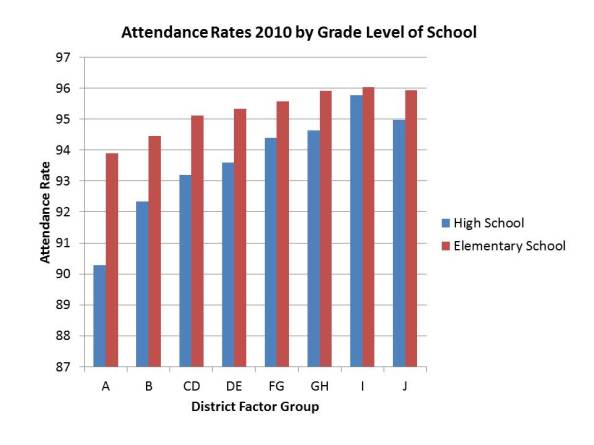 Enrollment Data: http://www.nj.gov/education/data/enr/
Enrollment Data: http://www.nj.gov/education/data/enr/
Attendance Data: http://education.state.nj.us/rc/rc10/index.html
*Note: In some parts of the NY Aid formulas, the local wealth measure for taxable assessed value per pupil uses a variant of ADA in the denominator. This use is generally much less significant to the overall calculation of aid than using ADA directly in the calculation of the foundation allotment.
[1] Green, P.C., Baker, B.D. (2006) Urban Legends, Desegregation and School Finance: Did Kansas City Really Prove that Money Doesn’t Matter? Michigan Journal of Race and Law. 12 (1)
Baker, B.D., Green, P.C. (2005) Tricks of the Trade: Legislative Actions in School Finance that Disadvantage Minorities in the Post-Brown Era American Journal of Education 111 (May) 372-413
[3] Killeen, K., Baker, B.D. Addressing the Moving Target: Should measures of student mobility be included in education cost studies? (Available on request)
[4] Stiefel, L., Berne, R., Chellman, C. (2005) School Finance Court Cases and Disparate Racial Impact. http://steinhardt.nyu.edu/scmsAdmin/uploads/005/819/School%20Finance%20Court%20Cases%20and%20Disparate%20Racial%20Impact%20-%20Stiefel,%20Schwartz,%20Berne,%20Chellman%20%28Feb%202005%29.pdf
[5]http://www.sde.ct.gov/sde/lib/sde/PDF/dgm/report1/merecsgd.pdf “Resident Students are those regular education and special education pupils enrolled at the expense of the town on October 1 of each school year.”
[6]https://stateaid.nysed.gov/budget/combaidsa_0910.htm For calculating Foundation Aid, which has been frozen since this point in time
[7]http://www.portal.state.pa.us/portal/http;//www.portal.state.pa.us;80/portal/server.pt/gateway/PTARGS_0_123706_1223690_0_0_18/EdBudget%202011-2012%20Estimated%20BEF%20Detail%20Feb2012.xlsx
[8]http://finance1.doe.mass.edu/chapter70/enrollment_desc.pdf. “In order to be included, a student must be officially enrolled on October 1st. Those who leave inSeptember or arrive after October 1st are not counted. A student who happens to be absent onOctober 1st is included nonetheless; this is a measure of enrollment, not attendance.”
[13]Green, P.C., Baker, B.D. (2006) Urban Legends, Desegregation and School Finance: Did Kansas City Really Prove that Money Doesn’t Matter? Michigan Journal of Race and Law. 12 (1) Baker and Green (2006) explain: “Missouri is among a handful of states that continues to provide aid to local public school districts on the basis of their average daily attendance (ADA) rather than enrolled pupil count or membership. From 2000 to 2004, poverty rates and black student population share alone explain 59% of variations in attendance rates across Missouri school districts enrolling over 2,000 students. Both black population share and poverty rate are strongly associated with lower attendance rates, leading to systematically lower funding per eligible or enrolled pupil in districts with higher shares of either population.”
This blog post has been shared by permission from the author.
Readers wishing to comment on the content are encouraged to do so via the link to the original post.
Find the original post here:
The views expressed by the blogger are not necessarily those of NEPC.
